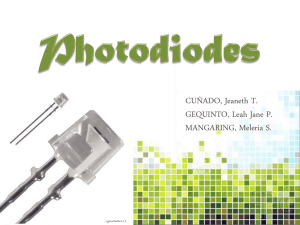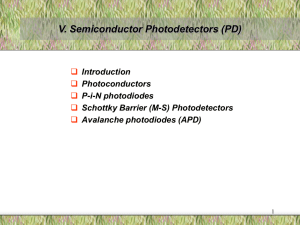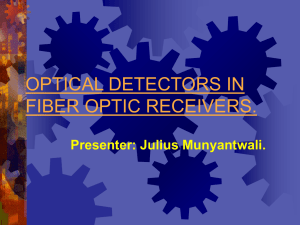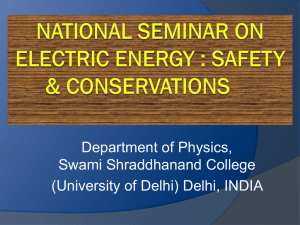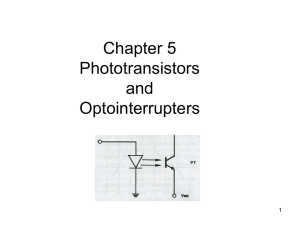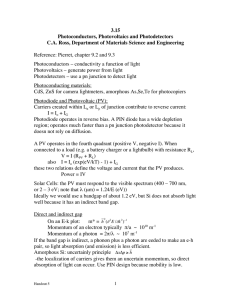Measurement of photodetectors
advertisement
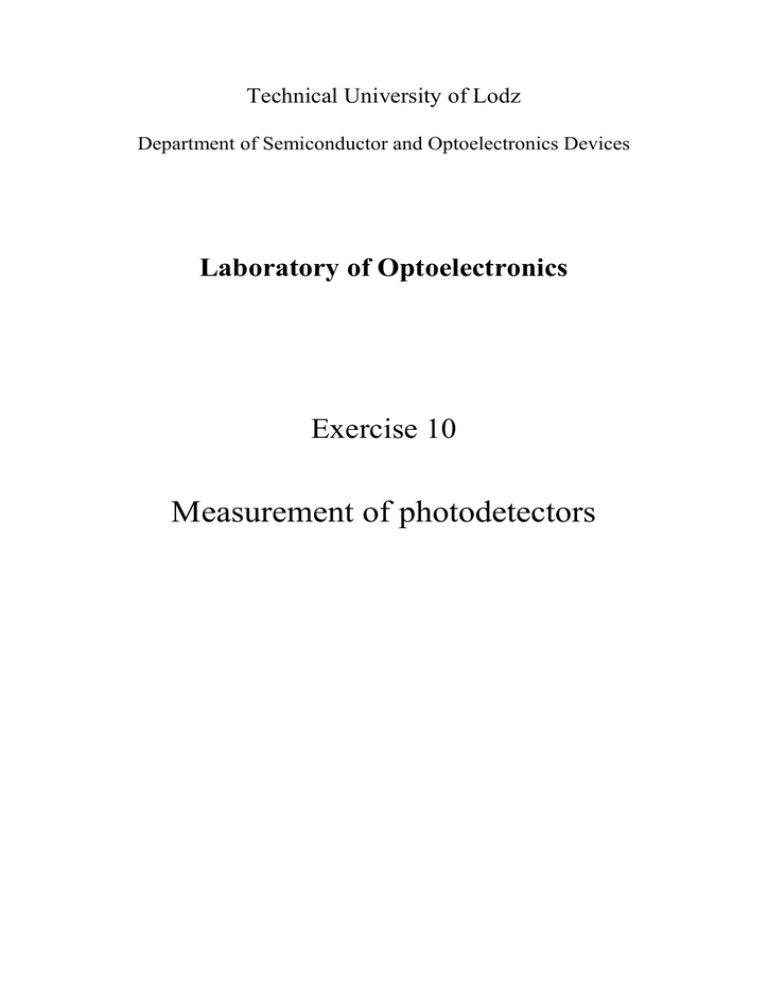
Technical University of Lodz Department of Semiconductor and Optoelectronics Devices Laboratory of Optoelectronics Exercise 10 Measurement of photodetectors 1. Theory Photodetectors are devices used for the detection of light – in most cases of optical powers. As the requirements for applications vary considerably, there are many types of photodetectors which may be appropriate in a particular case: • Photodiodes are semiconductor devices with a p–n junction or p–i–n structure (i = intrinsic material) (→ p–i–n photodiodes), where light is absorbed in a depletion region and generates a photocurrent. Such devices can be very compact, fast, highly linear, and exhibit a high quantum efficiency (i.e., generate nearly one electron per incident photon) and a high dynamic range, provided that they are operated in combination with suitable electronics. A particularly sensitive type is that of avalanche photodiodes, which are sometimes used even for photon counting. • Metal–semiconductor–metal (MSM) photodetectors contain two Schottky contacts instead of a p–n junction. They are potentially faster than photodiodes, with bandwidths up to hundreds of gigahertz. • Phototransistors are similar to photodiodes, but exploit internal amplification of the photocurrent. They are less frequently used than photodiodes. • Photoresistors are also based on certain semiconductors, e.g. cadmium sulfide (CdS). They are cheaper than photodiodes, but they are fairly slow, are not very sensitive, and exhibit a strongly nonlinear response. • Photomultipliers are based on vacuum tubes. They can exhibit the combination of an extremely high sensitivity (even for photon counting) with a high speed. However, they are expensive, bulky, and need a high operating voltage. • Pyroelectric photodetectors exploit a pyroelectric voltage pulse generated in a nonlinear crystal (e.g. LiTaO3) when heated by absorption of a light pulse on an absorbing coating on the crystal. They are often used for measurement of microjoule pulse energies from Q-switched lasers. • Thermal detectors (powermeters) measure a temperature rise caused by the absorption of light. Such detectors can be very robust and be used for the measurement of very high laser powers, but exhibit a low sensitivity, moderate linearity, and relatively small dynamic range. Important Properties of Photodetectors Depending on the application, a photodetector has to fulfill various requirements: • It must be sensitive in some given spectral region (range of optical wavelengths). In some cases, the responsivity should be constant or at least well defined within some wavelength range. It can also be important to have zero response in some other wavelength range; an example are solar-blind detectors, being sensitive only to shortwavelength ultraviolet light but not to sun light. • The detector must be suitable for some range of optical powers. The maximum detected power can be limited e.g. by damage issues or by a nonlinear response, whereas the minimum power is normally determined by noise. The magnitude of the dynamic range (typically specified as the ratio of maximum and minimum detectable power, e.g. in decibels) is often most important. Some detectors (e.g. photodiodes) can exhibit high linearity over a dynamic range of more than 70 dB. • In some cases, not only a high responsivity, but also a high quantum efficiency is important, as otherwise additional quantum noise is introduced. This applies e.g. to the detection of squeezed states of light, and also affects the photon detection probability of single-photon detectors. • The active area of a detector can be important e.g. when working with strongly divergent beams from laser diodes. For light sources with very high and/or nonconstant beam divergence, it is hardly possible to get all the light onto the active area. An integrating sphere may then be used (with appropriate calibration) for measuring the total power. • The detection bandwidth may begin at 0 Hz or some finite frequency, and ends at some maximum frequency which may be limited by internal processes (e.g. the speed of electric carriers in a semiconductor material) or by the involved electronics (e.g. introducing some RC time constants). Some resonant detectors operate only in a narrow frequency range, and can be suitable e.g. for lock-in detection. • Some detectors (such as pyroelectric detectors) are suitable only for detecting pulses, not for continuous-wave light. • For detecting pulses (possibly on a few-photon level), the timing precision may be of interest. Some detectors have a certain “dead time” after the detection of a pulse, where they are not sensitive. • Different types of detectors require more or less complex electronics. Penalties in terms of size and cost may result e.g. from the requirement of applying a high voltage or detecting extremely small voltages. • Particularly some mid-infrared detectors need to be cooled to fairly low temperatures. This makes their use under various circumstances impractical. • For some applications, one-dimensional or two-dimensional photodetector arrays are needed. For detector arrays, some different aspects come into play, such as cross-pixel interference and read-out techniques. • Finally, the size, robustness and cost are essential for many applications. Different detector types, as listed above, differ very much in many of these properties. In typical application scenarios, some requirements totally rule out the use of certain detector types, and quickly lead to a fairly limited choice. Note also that there are some typical tradeoffs. For example, it is frequently difficult to combine a high detection bandwidth with a high sensitivity. Photodiodes Photodiodes are frequently used photodetectors. They are semiconductor devices which contain a p–n junction, and often an intrinsic (undoped) layer between n and p layers. Devices with an intrinsic layer are called p–i–n or PIN photodiodes. Light absorbed in the depletion region or the intrinsic region generates electron–hole pairs, most of which contribute to a photocurrent. Photodiodes can be operated in two very different modes: Photovoltaic mode: like a solar cell, the illuminated photodiode generates a voltage which can be measured. However, the dependence of this voltage on the light power is nonlinear, and the dynamic range is fairly small. Also, the maximum speed is not achieved. Photoconductive mode: here, a reverse voltage is applied to the diode (i.e., a voltage in the direction where the diode is not conducting without incident light) and measures the resulting photocurrent. (It may also suffice to keep the applied voltage close to zero.) The dependence of the photocurrent on the light power can be very linear over six or more orders of magnitude of the light power, e.g. in a range from a few nanowatts to tens of milliwatts for a silicon p–i– n photodiode with an active area of a few mm2. The magnitude of the reverse voltage has nearly no influence on the photocurrent and only a weak influence on the (typically small) dark current (obtained without light), but a higher voltage tends to make the response faster and also increases the heating of the device. Current amplifiers (also called transimpedance amplifiers) are often used as preamplifiers for photodiodes. Such amplifiers keep the voltage nearly constant (e.g. near zero, or at some possibly adjustable negative bias), so that the photodiode is operated in the photoconductive mode. Current amplifiers can also have very good noise properties, and a better tradeoff for sensitivity versus bandwidth, compared with, e.g., simple circuits with a resistor and a voltage amplifier. Some commercially available amplifier devices help to make power measurements in the laboratory very flexible by providing many different sensitivity settings, and thus a huge dynamic range with low-noise performance, and also possibly a built-in display, adjustable bias voltage and signal offset, adjustable filters, etc. Figure 1: Current-voltage characteristics of a photodiode for different optical powers. Semiconductor Materials Typical photodiode materials are: • silicon (Si): low dark current, high speed, good sensitivity between roughly 400 and 1000 nm (best around 800–900 nm) • germanium (Ge): high dark current, slow speed due to large parasitic capacity, good sensitivity between roughly 900 and 1600 nm (best around 1400–1500 nm) • indium gallium arsenide phosphide (InGaAsP): expensive, low dark current, high speed, good sensitivity roughly between 1000 and 1350 nm (best around 1100– 1300 nm) • indium gallium arsenide (InGaAs): expensive, low dark current, high speed, good sensitivity roughly between 900 and 1700 nm (best around 1300–1600 nm) The indicated wavelength ranges can sometimes be substantially exceeded by models with extended spectral response. Key Properties The most important properties of photodiodes are: • the responsivity, i.e., the photocurrent divided by optical power – related to the quantum efficiency, dependent on the wavelength • the active area, i.e., the light-sensitive area • • the maximum allowed photocurrent (usually limited by saturation) the dark current (in photoconductive mode, important for the detection of low light levels) • the speed, i.e. the bandwidth, related to the rise and fall time, often influenced by the capacitance The speed (bandwidth) of a photodiode is typically limited either by electrical parameters (capacitance and external resistor) or by internal effects such as the limited speed of the generated carriers. The highest bandwidths of tens of gigahertz are usually achieved with small active areas (diameters well below 1 mm) and small absorption volumes. Such small active areas are still practical particularly for fiber-coupled devices, but they limit the photocurrents achievable to the order of 1 mA or less, corresponding to optical powers of ∼ 2 mW or less. Higher photocurrents are actually desirable for suppression of shot noise and thermal noise. Larger active areas (with diameters up to the order of 1 cm) allow for handling of larger beams and for much higher photocurrents, but at the expense of lower speed. The combination of high bandwidth (tens of gigahertz) and high photocurrents (tens of milliamperes) is achieved in velocity-matched photodetectors, containing several small-area photodetectors, which are weakly coupled to an optical waveguide and deliver their photocurrents into a common RF waveguide structure. The quantum efficiency of a photodiode is the fraction of the incident (or absorbed) photons which contribute to the photocurrent. For photodiodes without an avalanche effect, it is directly related to the responsivity S: the photocurrent is with the quantum efficiency η and electron charge e. The quantum efficiency of a photodiode can be very high – in some cases more than 95% – but varies significantly with wavelength. Apart from a high internal efficiency, a high quantum efficiency requires the suppression of reflections e.g. with an anti-reflection coating. In some cases, additional properties of photodiodes have to be observed, such as linearity of response over a wide dynamic range, the spatial uniformity of response, or the shape of the dynamic response (e.g. optimized for time domain or frequency domain), or the noise performance. The noise performance of photodiodes can be very good. For high photocurrents, it can be limited by shot noise, although thermal noise in the electronics is often stronger than that. For the detection of very low light levels (e.g. for photon counting), the dark current can also play a role. A higher responsivity (although sometimes at the cost of lower quantum efficiency) can be achieved with avalanche photodiodes. These are operated with a relatively high reverse bias voltage so that secondary electrons can be generated (as in photomultipliers). The avalanche process increases the responsivity, so that noise influences of subsequent electronic amplifiers are minimized, whereas quantum noise becomes more important and multiplication noise is also introduced. A photodiode is sometimes integrated into the package of a laser diode. It may detect some light getting through the highly reflecting back facet, the power of which is proportional to the output power. The signal obtained can be used, e.g., to stabilize the output power, or to detect device degradation. Phototransistors Phototransistors also consist of a photodiode with internal gain. A phototransistor is in essence nothing more than a bipolar transistor that is encased in a transparent case so that light can reach the base-collector junction. The electrons that are generated by photons in the base-collector junction are injected into the base, and this photodiode current is amplified by the transistor's current gain β (or hfe). Note that while phototransistors have a higher responsivity for light they are not able to detect low levels of light any better than photodiodes.[citation needed] Phototransistors also have slower response times. A simple model of a phototransistor, would be a forward biased LED (emitter–base) and a reverse biased photodiode (base–collector) sharing an anode (base) in a single package such that 99% (αF%) of the light emitted by the led is absorbed by the photodiode. Each electron-hole recombination in the LED produces one photon and each photon absorbed by the photodiode produces one electron-hole pair. MSM detector A metal–semiconductor–metal photodetector (MSM detector) is a photodetector device containing two Schottky contacts, i.e., two metallic electrodes on a semiconductor material, in contrast to a p–n junction as in a photodiode. During operation, some electric voltage is applied to the electrodes. When light impinges on the semiconductor between the electrodes, it generates electric carriers (electrons and holes), which are collected by the electric field and thus can form a photocurrent. MSM detectors can be made faster than photodiodes. Their detection bandwidths can reach hundreds of gigahertz, making them suitable for very high-speed optical fiber communications. PIN photodiode A p–i–n photodiode, also called PIN photodiode, is a photodiode with an intrinsic (i) (i.e., undoped) region in between the n- and p-doped regions. Most of the photons are absorbed in the intrinsic region, and carriers generated therein can efficiently contribute to the photocurrent. In Figure 1, the electrodes are shown in black: the cathode is a flat electrode, whereas the anode has the form of a ring (of which two opposite parts are seen in the shown cross section). The positive pole of the (reverse) bias voltage is connected to the cathode. On top of the p region, there is an anti-reflection coating. Figure 2: Schematic drawing of a p–i–n photodiode. The green layer is an anti-reflection coating. Compared with an ordinary p–n photodiode, a p–i–n photodiode has a thicker depletion region, which allows a more efficient collection of the carriers and thus a larger quantum efficiency, and also leads to a lower capacitance and thus to higher detection bandwidth. The most common p–i–n diodes are based on silicon. They are sensitive throughout the visible spectral region and in the near infrared up to ∼ 1 µm. At longer wavelengths, the absorption efficiency and thus the responsivity drops sharply, but the parameters of this cutoff depend on the thickness of the i region. For longer wavelengths up to ∼ 1.7 µm (or with extended spectral response up to 2.6 µm), InGaAs p–i–n diodes are available, although at significantly higher prices (particularly for large active areas). Germanium p–i–n diodes can be an alternative. The fastest p–i–n photodiodes have bandwidths of the order of tens of gigahertz. Their active areas typically have a diameter of only a few hundred microns. Some of them are available in fiber-coupled form and can be applied e.g. in receivers for optical fiber communications. 2. Measurements. The position of measurement. M250 monochromator (400-1200nm) Microprocessor controller monochromator. Software. Xenon lamp XBO 075 Figure 3. Monochromator Figure 4. Construction of the monochromator 2.1 Set the characteristics of the IDf(UD) photodiodes without light In this section we will examine exercise dark current flowing through the diode, in the absence of external lighting 2.2 Set the characteristics of the IDf(UD) photodiode with a given illumination In this section we examine the amount of current flowing through the photodiode, depending on the value of light intensity falling on it. 2.3 Set the spectral characteristics of the IDf(λ λ) photodiode The test consists of verifying sensitivity of LEDs on each length of radiation. To this end, we set a steady stream of light and through the monochromator we change the wavelength of radiation incident. For our monochromator perform a series of measurements in the range 400 - 1200 nm (eg at 100 nm). 2.4 Set the spectral characteristics of the IDf(λ λ) photodiode At this point, we perform measurements as well as in the previous section with the only difference is that the study will change the resistance Photoresistor for different wavelengths of radiation.

